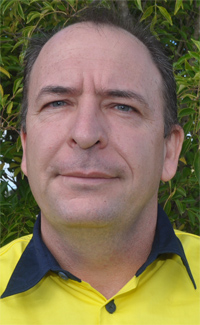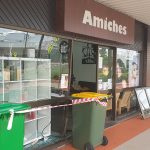
July 2, 2018
Moreton Resources informed the ASX on Monday that Jason Elks will be resigning as CEO of the company, a move he first flagged as early as August 2016.
However, he will remain Chairman of the Board of the mining company, which has plans to develop an open-cut coal mine on the outskirts of Kingaroy.
In a statement to the ASX, Mr Elks said he would not seek to renew his contract as CEO when it expired on November 23.
“As shareholders are aware, Mr Elks requested resignation of the entire board at the time he took on the role of CEO back in 2013 during the turbulent times for the company,” the statement said.
“Since that time, the company, under Mr Elks’ guidance, has significantly advanced its strategic activities to become a producer and Mr Elks has determined that the objectives he had set out have been achieved.
“Going forward, Mr Elks is keen to ensure he hands the role over to someone equally as capable to take the company forward to its next phase of growth and development.”
The statement to the ASX included a message from Mr Elks:
“It has been a significant journey and I am comfortable that my key objectives will be finalised and fulfilled by the close of this calendar year, and hence it is time to let the company evolve and prosper under new leadership. Whilst I will remain as Chairman post my final day as CEO, I will certainly enjoy some personal time and bring things back into perspective and balance.
“I have certainly thoroughly enjoyed the journey and believe the strategic objectives outlined below have been delivered in full or will in fact be closed out by the time I relinquish this role.”
Mr Elks listed the Kingaroy mine project as one of his strategic objectives:
“The advancement of the South Burnett Coal Feasibility Study, which in my view, will significantly improve the company’s prospects for realisation of this project. This study will incorporate a significant level of engineering, environmental, technical and social impact studies that should demonstrate the practical ways in realisation of significant reserve of coal (sic) that has potential for a long-term international off take agreements and therefore prosperity for the South Burnett region.”
The Moreton Resources’ statement to the ASX stated there was “no bigger priority” than “rapidly advancing the South Burnett Coal Project”.
* * *
In August 2016, Mr Elks announced his intention to resign as CEO “at an appropriate time and post resolution of the AAT (Administrative Appeals Tribunal) matters”.
At the same time, Mr Elks assumed the role of Executive Chairman “for an interim period”, replacing then-Chairman Wayne Penning. Moreton also announced it would begin the search for a new CEO.
The Australian Taxation Office has been seeking repayment of $1,003,455.22 for a 2012 research and development tax offset, and $7,182,269.41 for a 2013 R&D offset linked to the failed Cougar Energy underground coal gasification project at Coolabunia.
Moreton Resources – the renamed Cougar Energy – is still awaiting a decision from the AAT.
In a statement to the ASX on June 30, Moreton said a decision in its favour could lead to a payment of $6-$8 million to the company; however an adverse decision could see it paying about $9 million to the ATO, although R&D expenses that had previously been treated as non-deductible for taxation purposes would become deductible.
* * *
Meanwhile, Moreton Resources’ “coordinated project” declaration for the Kingaroy coal mine and associated transport corridor – a process begun in May 2016 – has lapsed.
The company’s South Burnett Coal Project and Kingaroy to Theebine Rail Corridor are now listed on the “Projects Discontinued Or On Hold” page of the Coordinator-General’s website
The declaration lapsed on June 19 – the cut-off date for the lodgement by Moreton of the Environmental Impact Statement / Terms of Reference for the project.
On June 20, Moreton told the ASX the company had “reviewed several times whether the (Office of the Coordinator General process) was the appropriate mechanism given the uncertainty and additional conditioning parameters available through the OCG process”.
“This led to a meeting in late December 2017 whereby the company highlighted its concerns with the process and what it viewed as fundamental failings of the OCG process.
“The lapse date of the current application therefore allows the company to determine its options.
“The most likely and practical option is to enter the Voluntary EIS approvals process under the Department of Environment and Science which, through statutory timing processes, would still allow for the company to have its EIS lodged for assessment within the next three to four months.”
External link:
Related articles:
- Moreton Delays Release of EIS
- Protest Group Targets Rail Crossings
- Moreton Says ‘Selective Mining’ Would Extract Cleaner Coal
- Coal Mine Decision ‘By Next Christmas’
- SB Coal Project ‘Well-Advanced’
- Moreton Outlines Plan To Pay Off Tax Debt
- Moreton To Secure Cash Flow
- Taabinga Declared A Coal-Free Community
- Moreton Aims For Coal In 2019
- Moreton ‘Praises’ KCCG Art Project
- Mine Fight Comes Alive With Art
- Moreton Gives Council Coal Mine Update
- Photo Shoot Captures Coal Mine Site
- KCCG Says Moreton Statement Misleading
- Moreton Aims For Rail Corridor
- Moreton Presses On With Mine Plan
- Moreton To Push Ahead With EIS
- Moreton Tax Bill Still In Limbo
- KCCG To Ramp Up Campaign
- Elks’ Role Cut Back Again
- Moreton Appoints Project Manager
- Moreton Starts Mine Approval Process
- KCCG To Make Mine Submission
- Moreton Applies For Mining Licence
- Greens Back Kingaroy Mine Protest
- KCCG Calls For Coal Permit Buyback
- Elks To Resign As Moreton CEO
- Another Step For Moreton Resources
- KCCG Demands Pre-Mining Health Tests
- Crowd Votes Down Mine … Again
- Moreton Faces $8m Tax Bill
- KCCG To Hold Second Anti-Mine Forum
- KCCG Plans Second Forum
- Nannas Take To The Highway
- Kingaroy Coal Mine To Require Federal Approval
- Moreton Looks For Silver Lining
- Between A Rock And Taabinga Village
- Moreton Re-issues Update
- Market Awaits Moreton News
- Moreton Predicts 400-600 Jobs At Mine
- Airport Blocks Cut From Coal Permit
- KCCG Rejects Phone Poll
- Phone Poll Backs Mine: Moreton
- Moreton Takes Mining Plan Out To The People
- KCCG Will Speak To Council
- Nannas Knit Against Mine
- KCCG Meets With State Government
- Coal Mine Fight Spreads
- Moreton Resources Unveils Mine Partner
- Meetings To Discuss Mine
- Moreton Plans To Start Seeking Permits
- Moreton’s Coal ‘Too Expensive’
- Kingaroy Coal Mine? No Way!
- Public Meeting To Discuss Coal Mine
- Stanwell Still Says ‘No’
- Moreton Releases Mine Study Results
- Moreton Resources Eyes Rail Link
- Moreton Buys More Resources
- Mining CEO Talks To Council
- KCCG Sees No Future For Mine
- Green Light For ‘Next Step’
- Moreton Board To Consider ‘Next Step’
- Moreton Resources Splits Off South Burnett Holdings
- Moreton Resources Extends Licence
- Controversial UCG Plant Vanishes
- UCG Plant Starts To Disappear
- Moreton To Begin Mine Concept Study
- Moreton Responds To MP’s Comments
- Moreton Aims To Press On
- Stanwell ‘Rejecting Billions In Savings’
- Stanwell Rules Out Moreton Coal
- ‘Enough Coal For 30-Plus Years’
- Concept Study Next Step For Proposed Coal Mine
- Moreton Triples Coal Estimates
- Coal Mine Review Delayed To July























